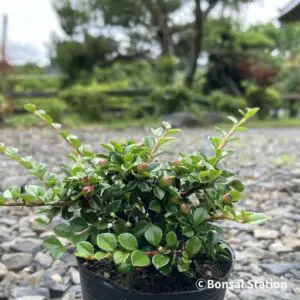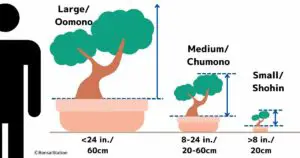The best indoor bonsai tree for a gift is dwarf jade because it is very easy to care for even as a beginner. The best outdoor bonsai tree for a gift is cotoneaster because it is highly resilient and the recipient can enjoy flowers, fruits as well as autumn colors.
Best bonsai trees for gift
Dwarf jade (indoor)
Brussel's Dwarf Jade Bonsai Tree
(Link to Amazon)
- Placement: indoor
- Tree type: evergreen
- Care: easy even for a beginner
What is dwarf jade?
Dwarf jade (Portulacaria afra) is a soft-wooded, semi-evergreen succulent shrub that can grow 8 to 15 feet tall in mild climates. Although succulent, the trunk and branches have a woody inner tissue; it thus looks like a tree rather than a cactus.
Why is dwarf jade a good gift choice?
Dwarf jade is one of the best choices as a bonsai gift because it is easy to care for and to keep the bonsai shape even as a beginner. Specifically;
- Its dense branching gives a full-grown look as a bonsai tree;
- It readily produces buds wherever branches or leaves are removed; and
- It is easy to keep in almost any size or shape by pinching or pruning just above a pair of leaves.
The small root ball adapts well to shallow bonsai containers as well. Being succulent, it is more tolerant of drying than traditional bonsai species such as maples or coniferous trees, which require more constant attention.
Dwarf jade care
| Common name | Dwarf jade |
| Latin name | Portulacaria afra |
| Native area | South Africa |
| Sun exposure | South-facing window (eastern/western exposure acceptable) |
| Cold tolerance | Low (40°F/5°C) |
| Heat tolerance | Moderate (75°F/24°C) |
| Drought tolerance | High |
| Soil | Very well-drained |
| Fertilization | Once a month in growing season |
| Watering | Water when dry Restrict watering in winter |
Cotoneaster (outdoor)
- Placement: outdoor
- Tree type: deciduous/flower/fruit
- Care: easy, highly resilient
What is rockspray cotoneaster?
Rockspray cotoneaster is a dense, slow-growing deciduous shrub that reaches 2-3 feet tall and 6-8 feet wide, with tiny oval-shaped dark green leaves turn orange and red in autumn. It blossoms with clusters of small white or pink flowers in spring and summer, followed by showy red, purple or black berries, which makes it very enjoyable all year round. Although deciduous, it is semi-evergreen to evergreen in its southern reaches.
Why is rockspray cotoneaster a good gift choice?
Cotoneaster is one of the best choices as a bonsai gift as the recipient can enjoy flowers, fruits and autumn leaves, all by having one tree. It is also strong as species that can tolerate drought, hot/cold weather and hard pruning.
Rockspray cotoneaster care
| Common name | Rockspray cotoneaster |
| Latin name | Cotoneaster horizontalis |
| Native area | Asia, Europe, North Africa |
| Sun exposure | Outside, high to partial shade |
| Cold tolerance | High |
| Heat tolerance | Moderate |
| Drought tolerance | High |
| Soil mix | Well-drained |
| Fertilization | Twice each in Apr, May, Sept, Oct |
| Watering | Once/day in spring and fall 2 times/day in summer Once every 2 days in winter |
Ficus (indoor)
Ficus Ginseng Microcarpa Bonsai
(Link to Amazon)
- Placement: indoor
- Tree type: evergreen
- Care: easy
What is ginseng ficus?
Ginseng Ficus (Ficus retusa) is a broadleaved, evergreen tree native to Southeast Asia. In nature, its trunk can grow up to 3.3ft (1m) in diameter and it can reach 33ft (10m) in height with spreading crown.
Why is ginseng ficus a good gift choice?
Although it grows in a tropical rainforest climate, ginseng ficus can be a houseplant growing indoors and is tolerant to dryness and low temperature to some extent. Ginseng ficus is one of the best choices as a bonsai gift because it is strong and resilient as species and can tolerate low humidity inside the house.
Ginseng ficus care
| Common name | Ginseng Ficus |
| Latin name | Ficus retusa |
| Native area | Southeast Asia (Malaysian peninsula) |
| Sun exposure | South-facing window |
| Cold tolerance | Low (50°F/10°C) |
| Heat tolerance | Moderate (85°F/30°C) |
| Drought tolerance | Low |
| Soil | Well-drained (can tolerate impeded soil) |
| Fertilization | Once a month in growing season |
| Watering | Water when slightly dry |
Japanese maple (outdoor)
- Placement: outdoor
- Tree type: deciduous
- Care: easy, resilient
What is Japanese maple?
Japanese maples (Acer palmatum) are native to Japan, Korea, and China reaching a height of 50 ft (15m) in nature. They have been cultivated in Japan for a few hundred years to make different types of leaves for bonsai.
Why is Japanese maple a good gift choice?
Japanese maple is one of the most popular bonsai species with beautiful new green leaves in spring and exceptionally bright orange/red in autumn. It is one of the strongest bonsai species that can tolerate hot and cold weather.
There are 50 or so Japanese maple bonsai cultivars, of which around 10 are popular. Each has a different leaf size, shape and color, such as curly shape, green color with red at the edge or red throughout the season.
To choose which cultivar to give as a present, please read the following post.
Japanese maple care
| Common name | Japanese maple |
| Latin name | Acer palmatum |
| Native area | Japan, Korea, China |
| Sun exposure | Outside, high to partial shade |
| Cold tolerance | High (14°F/-10°C) |
| Heat tolerance | High (100°F/37°C) |
| Drought tolerance | Fairly low |
| Soil mix | Well-drained |
| Fertilization | Once each in Apr, May, Sept, Oct |
| Watering | Twice/day in spring and fall 3 times/day in summer Once every 2 days in winter |
Why bonsai trees are good for present
Timeless gift that can last forever
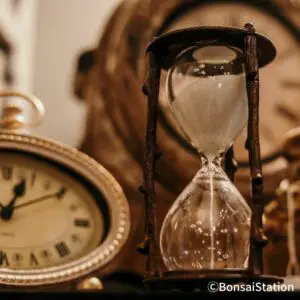
Depending on the species, a bonsai tree can live more than 1000 years if it is cared for properly. It can live a few decades easily even if it is managed by an ordinary bonsai grower.
Bonsai trees will not evaluate over time and each tree is unique, which is good if you are giving a bonsai tree to your loved ones.
Can be a lifelong hobby
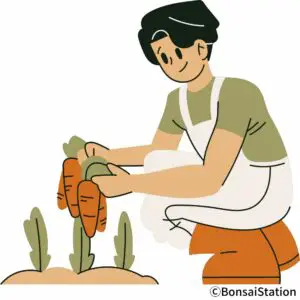
Growing a bonsai tree can be a lifelong hobby for the person you are giving one. As bonsai trees can never be “perfect” and constantly changing, it can be a long-lasting passion and pursuit for their own ideal.
It can also be a stress reliever and source of inspiration for creativity that 9 to 5 city workers desperately need these days.
Art form that brings natural landscape to home

Bonsai is the Art of Miniature Landscape: a natural landscape created with plants in a bonsai pot. It is not just a small tree planted in a pot but rather the tree, the soil, the moss and everything in it are to be regarded as the reflection of nature’s beauty.
A bonsai tree can bring the beauty of nature from the comfort of their own home.
Evergreen trees are a symbol of luck
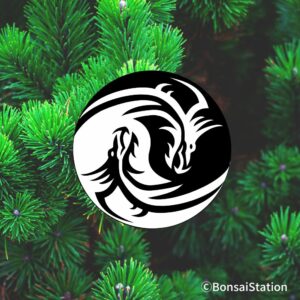
Evergreen trees including bonsai symbolize fortune, prosperity and longevity according to Feng Shui and Japanese tradition. Besides evergreens, people sometimes use deciduous tree species such as maple trees as Feng Shui tree in different regions of Asia.
As such, having those bonsai trees can bring luck if you believe in it.
For more detail on this topic, please read the following post.
Things to consider when gifting bonsai trees
Indoor/outdoor

Consider where the recipient of your gift can place your bonsai gift; indoor or outdoor. If he or she does not have a backyard or balcony to put it outdoors, your choice of bonsai tree species should be indoor plants that can be made into bonsai, such as jade and ficus.
Note that most bonsai trees are best suited to grow outdoors and cannot stay healthy if they are put inside the house.
Size
Size of the bonsai tree is important to consider. It might be surprising to you but smaller bonsai trees are more difficult to take care of for a beginner, at least to keep the tree shape. As a living creature, a bonsai tree is constantly growing. This means that it should be pruned and shaped regularly to keep the tree as it is or it grows to be an ordinary tree.
Watering is another challenge since small bonsai trees’ pots are tiny and the soil can easily be dried up, especially in the hot season. It needs to be watered regularly when dried but cannot be overwatered due to the risk of root rot.
Climate/temperature

Climate/temperature of the place where your bonsai gift will be placed is another consideration. Every plant has a certain level of tolerance to heat/cold and dryness/humidity. Depending on where the recipient of your gift lives, certain bonsai species are more suitable than others.
Amount of sunlight

Whether or not your gift is indoor or outdoor bonsai, trees need sunlight to thrive. It is their primary source of energy which cannot be replaced by fertilizer. And the amount of sunlight a tree needs differs from one to another. Some need plenty of direct sunlight, others prefer being in shade.
If your recipient may place your gift under a fairly low amount of light, your choice has to be a tree that does well in lower-light conditions. If he/she places it under plenty of strong sunlight, the tree should be species that tolerate direct sunlight.
Plant lover or not
You might have to consider if the recipient of your gift is a plant lover or not. Unless he/she may love to take care of plants or has some experience in growing one, giving a living thing like a plant might not be as thrilling as you might think.


